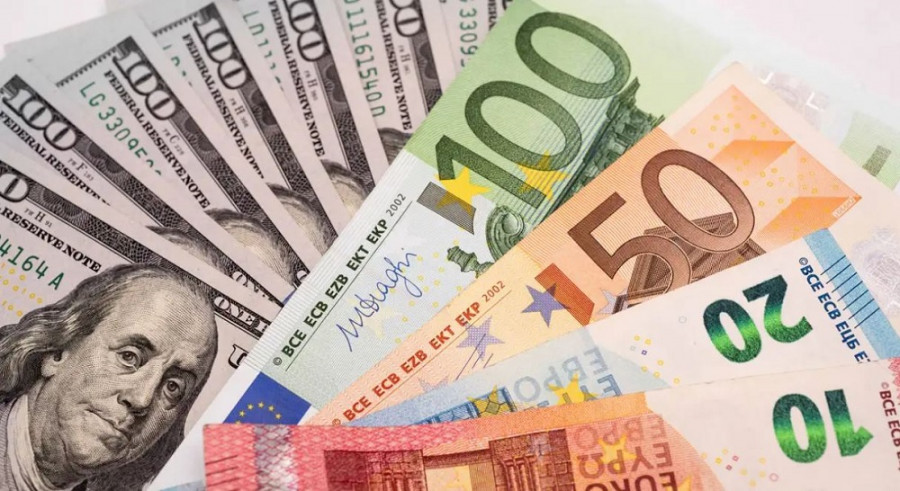The EUR/USD pair is drifting lethargically around the 1.0950 level at the start of the new trading week. The bears initially had the initiative, attempting to pull the pair towards the 1.09 handle. However, the downward movement stalled around the 1.0920 level. Then the sellers took the initiative but they also failed to demonstrate any impressive results. Traders are not eager to open large positions with an almost empty economic calendar - neither bulls or bears. Especially since key macroeconomic releases of the week will be published later. For now, both sides have their arguments for the "tug of war" within the 1.09 handle. However, for a decisive move - above 1.1000 or below 1.0900 - a powerful impetus is needed. In the absence of such a catalyst, traders are forced to jostle in a relatively narrow price range, so to speak, "in waiting mode."
Dollar
On the side of the dollar, there is a slight weakening of dovish expectations regarding the Federal Reserve's future course of actions and an increase in risk-off sentiment in the markets.
After the December Non-Farm Payrolls report, the probability of a 25 basis point rate cut in March has decreased to 60%. At the same time, the probability of keeping the status quo has increased to 36% (the remaining 4% is the probability of a 50-point rate cut). Last week, ahead of the release on Friday, the probability of a rate cut in March was 75%. Although the Non-Farm Payrolls report had its flaws, and the ISM Services PMI even fell into the "red," the market started to doubt that the Fed would start cutting rates in early spring. This provided support for the US dollar.

The rise in geopolitical tensions also supports the greenback. The focus is once again on the Middle East. Two days ago, Lebanon warned Israel of the danger of a large-scale war between the two countries. Lebanese Prime Minister Najib Mikati demands that Israel withdraw from the Gaza Strip, warning of the risk of further escalation in the region with the potential for a full-scale war "due to any strikes on the south of Lebanese territory."
The situation in the Red Sea remains tense as well. As is known, the rebel movement based in Yemen recently attacked a number of ships in the southern part of the Red Sea, including the Maersk vessel. This disrupted global trade and raised concerns about a new surge in global inflation, as shipping rates sharply increased.
The rise in risk-off sentiment in the markets provides background support for the greenback, but it's not enough to organize even a modest dollar "mini-rally."
Euro
Inflation is on the euro's side. Eurozone inflation rose to 2.9% in December, which is half a percentage point higher than in November. The inflation reports in the EU countries also reflected the growth of indicators. The strongest growth rates were recorded in Slovakia (6.6%) and Austria (5.7%). The largest economies in the European region also saw significant inflation rates: in Germany, inflation reached 3.8% in December, and in France, it was 4.1%. The main drivers of price increases were higher food, alcohol, and tobacco prices (+6.1%), services (+4%), and industrial goods (+2.5%). On the other hand, energy fell in price by 6.7% relative to December 2022. But there is also a nuance here: in November, this component of the report decreased by 11.5% at once. European Central Bank President Christine Lagarde said at the end of last year that she expects a new round of inflation after the elimination of subsidies for fuel, gas and electricity. In this context, she specified that the central bank would probably not start cutting interest rates before "the next couple of quarters".
Lagarde's predictions have come true: energy subsidies have indeed been canceled, and inflation in the eurozone (following Germany and France) has indeed started to pick up. The dovish expectations for further ECB actions have consequently weakened.
This is why the upcoming U.S. inflation reports will play a very significant, if not determining, role for the dollar and, consequently, for the EUR/USD pair. What's at stake here is the emerging divergence in the policies of the Federal Reserve and the ECB. If inflation in the United States once again shows a downward trend, the probability of the Fed lowering interest rates in March will increase. This would allow the bulls to attack and aim for 1.1010 (the Tenkan-sen line on the daily chart). However, if the inflation figures have a "green hue," in this case, bears will likely take the initiative, and aim for 1.0850 level (the upper band of the Kumo cloud on the same timeframe). Just a reminder, the US Consumer Price Index will be published on Thursday (January 11th), and the Producer Price Index will be released on Friday.
The material has been provided by InstaForex Company - www.instaforex.comfrom Forex analysis review https://ift.tt/MbvKhds
via IFTTT
